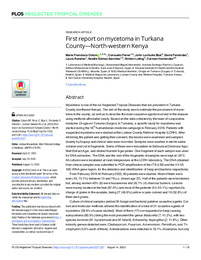Título :
First report on mycetoma in Turkana County—North-western Kenya |
Autor :
Colom Valiente, María Francisca 
Ferrer, Consuelo
LOCHUKE, JOHN EKAI 
Ferrández, David
Ramírez, Laura
Gomez-Sanchez, Noelia 
Leting, Simion
Hernández, Carmen |
Editor :
Public Library of Science Plos |
Departamento:
Departamentos de la UMH::Producción Vegetal y Microbiología |
Fecha de publicación:
2023 |
URI :
https://hdl.handle.net/11000/37777 |
Resumen :
Mycetoma is one of the six Neglected Tropical Diseases that are prevalent in Turkana
County (northwest Kenya). The aim of the study was to estimate the prevalence of mycetoma
in the county, as well as to describe the main causative agents involved in the disease
using methods affordable locally. Based on the data collected by the team of cooperative
medicine Cirugia en Turkana (Surgery in Turkana), a specific study for mycetoma was
started during the 16th humanitarian medicine campaign in February 2019. Patients with
suspected mycetoma were studied at the Lodwar County Referral Hospital (LCRH). After
informing the patient and getting their consent, the lesions were examined and sampled
(mainly by biopsy) and clinical data were recorded. Samples were washed in sterile saline
solution and cut in fragments. Some of these were inoculated on Sabouraud Dextrose Agar,
Malt Extract Agar, and diluted Nutrient Agar plates. One fragment of each sample was used
for DNA extraction. The DNA and the rest of the fragments of samples were kept at -20˚C.
All cultures were incubated at room temperature at the LCRH laboratory. The DNA obtained
from clinical samples was submitted to PCR amplification of the ITS-5.8S and the V4-V5
16S rRNA gene region, for the detection and identification of fungi and bacteria respectively.
From February 2019 till February 2022, 60 patients were studied. Most of them were
men (43, 74,1%) between 13 and 78 y.o. (mean age 37). Half of the patients were herdsmen
but, among women 40% (6) were housewives and 26.7% (4) charcoal burners. Lesions
were mainly located at the feet (87.9%) and most of the patients (54; 93.1%) reported discharge
of grains in the exudate, being 27 (46.6%) yellow or pale colored and 19 (32.8%) of
them dark grains.
Culture of clinical samples yielded 35 fungal and bacterial putative causative agents. Culture
and molecular methods allowed the identification of a total of 21 causative agents of
mycetoma (39.6% of cases studied). Most of them (17) corresponded to fungi causing
eumycetoma (80.9%) being the most prevalent the genus Madurella (7; 41.2%), with two
species involved (M. mycetomatis and M. fahalii), followed by Aspergillus (2; 11.8%). Other
minority genera detected were Cladosporium, Fusarium, Acremonium, Penicillium, and Trichophyton
(5.9% each of them). Actinobacteria were detected in 19.1% of samples, but only Streptomyces somaliensis was identified as a known agent of mycetoma, the rest being actinobacteria
not previously described as causative agents of the disease, such as Cellulosimicrobium
cellulans detected in two of the patients.
Although Kenya is geographically located in the mycetoma belt, to our knowledge this is
the first report on mycetoma in this country from 1973, and the first one for Turkana County
|
Palabras clave/Materias:
Mycetoma
Turkana County
Eumycetoma
Actinobacteria |
Tipo de documento :
info:eu-repo/semantics/article |
Derechos de acceso:
info:eu-repo/semantics/openAccess
Attribution-NonCommercial-NoDerivatives 4.0 Internacional |
DOI :
https://doi.org/10.1371/journal.pntd.0011327 |
Publicado en:
PLOS Neglected Tropical Diseases, 17(8), e0011327 - August 2023 |
Aparece en las colecciones:
Artículos - Producción vegetal y microbiología
|

 La licencia se describe como: Atribución-NonComercial-NoDerivada 4.0 Internacional.
La licencia se describe como: Atribución-NonComercial-NoDerivada 4.0 Internacional.
.png)